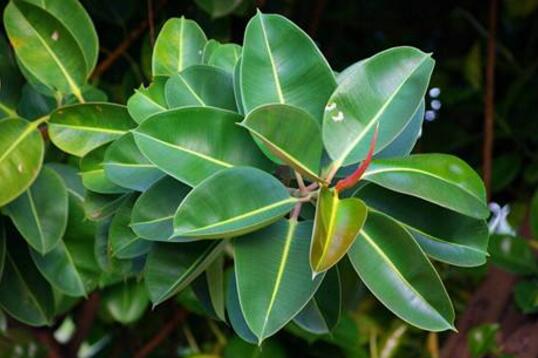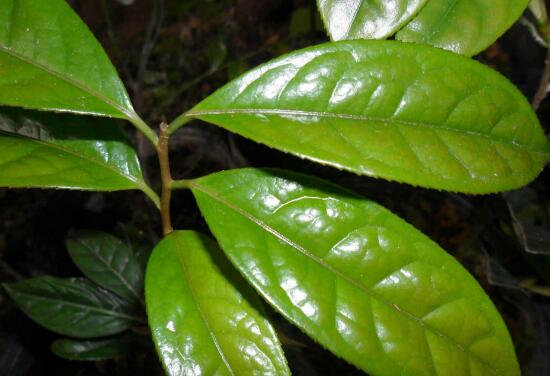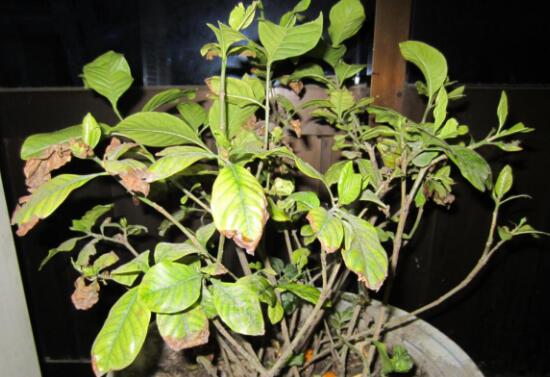How does the rubber tree lose its leaves, caused by five reasons / with solutions
Usually, the leaves of rubber trees are bright and straight, but some flower friends will encounter the loss of a large number of leaves of rubber trees, which not only affects their appearance, but also indicates problems in the health of rubber trees. so how did the rubber tree lose its leaves? The editor sorted out several common reasons and solutions for your reference.
How did the rubber tree lose its leaves?
1. Too little watering

Reason: rubber trees prefer a humid environment. If they are not watered for a long time or simply watered a little at a time, the plants will grow poorly due to lack of water, and the old leaves will fall early.
Method: pay attention to reasonable watering, which needs to be watered once a day in summer and 3-4 days in spring and autumn. You can reduce watering in winter and try to keep the soil moist.
2. Root rot
Cause: there are many reasons for root decay, such as stagnant water, injuring roots when changing pots, unclean soil, and so on. Once there is rot and there is no timely treatment, it will cause poor absorption of nutrients in the roots. Then the leaves will not be able to get enough nutrition, and the phenomenon of leaf loss will occur.
Method: usually do not water too much, do not let the roots of rubber trees soak in water for a long time, when changing pots, you should be careful to cut the roots, and the soil used to plant rubber trees should be kept clean and tidy and should be disinfected.
3. The temperature is too low
Reason: in the cultivation method of rubber tree, we know that it needs to be kept warm in winter. What if the rubber tree loses its leaves in winter? The reason is that the temperature is too low, below 5 degrees and do not take heat preservation measures, it will cause a large number of leaves to fall.
How to do this: cut off all the top leaves and take measures to keep the rubber tree warm, such as putting on an insulation film or moving it to a warm room, while allowing the rubber tree to receive plenty of light.
4. Soil consolidation
Reason: when choosing soil, it should be loose and breathable, but sometimes the conditions are limited, and the quality of the soil is not high. In addition, the soil has not been changed for a long time, which leads to the consolidation of the soil. Even watering and fertilization can not let nutrients into the soil, the roots will lose leaves because of lack of nutrition.
Method: the soil used should be mainly sandy soil such as garden soil and rotten leaf soil, and then choose whether or not to change the basin every 1-2 years according to the soil conditions. if the soil does not form a mass, it means that the air permeability is relatively poor, and the soil should be changed in time.
5. caused by diseases and insect pests
Reason: there are many diseases that can cause rubber trees to lose their leaves, such as Botrytis cinerea and so on. At first, the leaves are just diseased, which will wither and fall if they are not treated in time.
Method: the emergence of diseases and insect pests should be timely sprayed with drugs, and more is to prevent the emergence of diseases and insect pests, such as ensuring adequate light, environmental ventilation, moderate humidity, can reduce the occurrence of diseases and insect pests, the phenomenon of leaf loss will also be significantly reduced.
How to raise a rubber tree? how does a rubber tree lose its leaves? the culture method of a rubber tree.
Rubber tree is a good plant for home decoration, with large leaves and bright green color, not only can be used to watch, but also the vitality of rubber tree is very tenacious, there is no need to bother to raise it. But sometimes in the process of breeding, we will find that the rubber tree has lost its leaves. So what is the reason for this? How to raise a rubber tree? Next, the editor will briefly introduce the content of this aspect for you, and serve as a reference for everyone to cultivate rubber trees.
First, how did the rubber tree lose its leaves?
1. Temperature is too low or too high
Hevea brasiliensis is a plant with tropical characteristics, which is fond of high temperature environment. The best growth temperature is 20-25 ℃. If the rubber tree loses its leaves, it is probably because the temperature is below 10 ℃, or the temperature is more than 30 ℃. Therefore, when the temperature begins to drop gradually in winter, the rubber tree will gradually lose its leaves, and it should be cultured in an indoor temperature of no less than 10 ℃. If it is summer, when the leaves fall off, you need to move them to a cool place for shade.
2. Lack of sunshine
Rubber trees like a sunny environment and need plenty of light every day. If there is not enough light, it will also cause the loss of leaves. So to put the rubber tree in a sunny place for cultivation, winter sunshine for a short time, but also to ensure that there is enough sunshine every day, preferably Quanyang.
3. Improper watering
Rubber trees like a humid environment and need plenty of water. In the midsummer growth period, the temperature is high, the water evaporation is fast, the rubber tree needs a lot of water, not only the roots of the rubber tree should be watered, but also the leaves should be sprayed with appropriate amount of water. But be careful not to have stagnant water, or it will rot the roots and cause the leaves to fall. In addition, without watering for a long time, the basin soil is too dry to make the rubber tree lose its leaves, so watering must be timely and appropriate.
4. Influence of insect pests
Leaves are affected by red spiders and shell insects, resulting in insect pests and diseases, and the leaves will fall. Therefore, when the rubber leaves fall, it is necessary to check whether it is caused by insect pests, and if so, buy appropriate pesticides for spray control.
Second, how to raise rubber trees
1. Temperature
The best growth temperature of rubber tree is 20-25 ℃, no more than 30 ℃ in summer and no less than 10 ℃ in winter, so it should be moved to a cool place when the temperature is too high in summer and cold protection should be done when the temperature is too low in winter.
2. Lighting
Rubber trees like the sunny environment, when breeding must ensure that there is sufficient light time, in May-September when the sun is strong can be a proper shade.
3. Soil
Rubber trees grow well in neutral and acidic soil, so rotten leaf soil, garden soil and river sand can be used to form culture soil with a small amount of base fertilizer, and keep the soil drainage smooth and loose, and often loosen the soil.
4. Fertilizer
Nitrogen fertilizer is the main fertilizer, which can make the leaves brighter and reduce the occurrence of markings. Rarefied liquid fertilizer can be applied every 15 days. After entering autumn, the application of fertilizer can be reduced to make the plant grow stronger, and stop fertilizing in winter.
5. Watering
When the summer is hot, the rubber tree needs a lot of water, so it is necessary to ensure that there is sufficient water in the roots and leaves, but to avoid stagnant water in the basin. Low temperature in winter, watering can be a small amount, just keep the soil moist. Overnight tea can be watered and the whole plant should be sprayed with water.
6. Pruning and turning the basin
In spring, in order to ensure the good ventilation and growth of the rubber tree, it is necessary to prune the rubber tree, which can cut off the branches, inward branches, weak branches and other branches inside the crown. At the same time, it also needs to turn the basin every 2 years, and rotten leaf soil and other soil with fertile matrix can be added when turning the basin to ensure the looseness and good drainage of rubber tree soil.
Culture methods of rubber trees
The reason for the loss of leaves of rubber trees is related to temperature, light, watering, pests and other factors. When breeding, we should pay attention to the work of preventing cold and keeping warm, and give the rubber trees full light, timely and appropriate watering, regular spraying of pesticides, as long as patient maintenance, the growth of rubber trees will develop towards a good state.
How to raise indoor potted black King Kong rubber tree?
Black King Kong rubber tree, also known as Indian rubber tree, rubber tree, etc., originated in India and Malaysia and other places, and now there are many cultivation in various parts of our country. It is a common ornamental tree and street tree in the garden, which is very suitable for indoor beautification. Small and medium-sized plants are often used to beautify the living room and study, while medium and large plants are suitable for being arranged on both sides of the foyer and in the center of the lobby of large buildings. Let's take a look at how to raise black rubber trees.
Growth habits of Black King Kong Rubber Tree
Black King Kong rubber tree likes high temperature, humid, sunny environment, suitable growth temperature 20: 25 ℃, avoid direct sunlight, but also can bear shade but not cold, safe overwintering temperature is 5 ℃. Resistant to air dryness. Avoid clayey soil, not resistant to barren and drought, like loose, fertile and well-drained slightly acidic soil.
Propagation method of Black King Kong Rubber Tree
1. Cutting method: the cutting time is in late spring and early summer, which can be combined with pruning. Cuttings often choose one-year-old semi-lignified middle branches, and the wound should be sealed in time with cement or plant ash. The length of cuttings is to keep 3 buds as the standard, cut off the lower leaf, close the upper two leaves, and tie them with a thin plastic rope. The cuttings are then cut on a bed with plain sand or frog stone as the substrate. Keep the plug-in bed with high humidity after insertion, but do not accumulate water, the suitable temperature is 18-25 ℃, often sprinkle water to the ground to improve air humidity, and do a good job of shading and ventilation, it can take root in about 2-3 weeks.
2. Striping method: select 2-year-old branches with appropriate size, good development and abundant tissue, and make a light circular peeling of about 1 cm in width in the predetermined part of the soil, and apply 30~50ppm 's naphthalene acetic acid solution, then wrap the ring cutting part with wet soil or moss mixture or vermiculite that absorbs enough water, wrap it with plastic film on the outside, tie it tightly at the lower end, and leave holes at the upper end to facilitate ventilation and irrigation. Pay attention to maintenance, pressing in June and rooting from July to August. After taking root, the potted plant can be cut off.
Culture method of Black King Kong Rubber Tree
1. Rational fertilization: the fertilization of black King Kong rubber tree should be based on nitrogen fertilizer, with a small amount of phosphorus and potassium fertilizer. Can use retting soybean water, bean cake water diluted after filling the root, the general concentration of 20%. Can also use inorganic fertilizer, such as urea, but to achieve less frequent application, do not apply thick fertilizer, avoid burning roots.
2. Soil configuration: it is advisable to use 1 part of rotten leaf soil, 1 part of garden soil and 1 part of river sand and a small amount of base fertilizer to form culture soil when black rubber tree is planted in pot. It grows very fast in a hot and humid environment, producing a leaf every 5 to 10 days, during which sufficient fertilizer and moisture must be ensured.
3. Light management: black King Kong rubber tree likes strong sunlight, so it should be cultivated in the sun during the whole growing season from spring to autumn and in strong light in winter. But it can also tolerate shade, and it is better to be cultivated in low light indoors.
4. Temperature control: the suitable temperature for the growth of Hevea brasiliensis is between 20 and 30 ℃, and the growth is the most luxuriant at 25 to 30 ℃. The growth is poor when it is less than 10 ℃, and it is easy to suffer frost injury when it is less than 0 ℃. If the black King Kong rubber tree is hit by a cold wind, there will be yellow leaves and fallen leaves.
5, timely watering: black King Kong rubber tree likes water, but is not resistant to water stains, there is a waterlogging phenomenon, the root can not get oxygen, there will be yellow leaves, fallen leaves. Watering should follow the principle of "see dry and wet". Don't water too often. Winter should be spent indoors, generally watered once a week, summer should be decided according to the weather and basin soil humidity!
6. Reasonable pruning: in order to make the black rubber tree grow symmetrically and ensure a good plant shape, it should be coring when the seedlings grow to a height of 50 cm to 80 cm, so as to promote the germination of lateral branches. After the lateral branches grew, 3-5 branches were selected, and then the opposite lateral branches were cut once a year, and the larger plants with complete plant shape and round plump could be obtained after 2-3 years.
7. Pest control
① leaf spot: if leaf spot is found in black King Kong rubber tree, it can be sprayed with chlorothalonil or carbendazim, once a week, 2 or 3 times in a row.
② anthrax: anthrax is not easy to be found at first. At first, it is just a small brown spot on the leaves. If it is not treated in time, it will quickly expand into a piece, making it lose its ornamental value. Therefore, once the disease is found, 400 times methyl topiramate should be sprayed on the leaf, once a week, 3 times in a row, which can generally be cured.
③ rot root disease: rot root disease is generally caused by Rhizoctonia or Pythium infection in the soil or caused by its physiological diseases, bacterial infection can be treated with dimethazone, carbendazim, or Wulu nitrobenzene 500x liquid root irrigation treatment, physiological diseases are mostly due to the soil is too sticky and heavy, watering too often, the root system can not absorb, can be replaced with well-drained soil.
- Prev

What if the leaves of Jinhua tea turn yellow? pay attention to the yellowing at 6 o'clock / increase the light and change the soil.
Golden scented tea, the twin sister of Camellia and Camellia, has beautiful flowers and golden colors, and is known as the giant panda in the plant world. In life, because of the strong efficacy of golden scented tea, many people keep it at home, but in the process of breeding, many of them will encounter yellow leaves. So, what if the leaves of golden scented tea turn yellow?
- Next

Goose palm wood leaves yellowing how to do, 5 reasons and remedies / focus on light
Goose palm wood, a healthy green plant, not only looks beautiful, but also can absorb nicotine and harmful gases and take care of people's health, so many families will raise a pot. But in the process of breeding, many flower friends will encounter the symptoms of yellow leaves, that goose palm wood leaves yellow how to do? To this
Related
- Fuxing push coffee new agricultural production and marketing class: lack of small-scale processing plants
- Jujube rice field leisure farm deep ploughing Yilan for five years to create a space for organic food and play
- Nongyu Farm-A trial of organic papaya for brave women with advanced technology
- Four points for attention in the prevention and control of diseases and insect pests of edible fungi
- How to add nutrient solution to Edible Fungi
- Is there any good way to control edible fungus mites?
- Open Inoculation Technology of Edible Fungi
- Is there any clever way to use fertilizer for edible fungus in winter?
- What agents are used to kill the pathogens of edible fungi in the mushroom shed?
- Rapid drying of Edible Fungi

